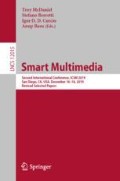Abstract
Training caregivers in pivotal response treatment (PRT) has been shown to help improve communication skills in children with autism. PRT training programs are implemented by clinicians that provide instruction, modelling, and assessment. Assessments are based on video recordings of the caregivers interacting with their children. Multimodal processing technologies could alleviate the costs involved in analyzing videos and providing performance-based feedback.
Constructing a user interface (UI) for clinicians to view data extracted from PRT videos is an important aspect for creating a feedback system. Including clinicians throughout the design and development process ensures that the application fully meets the user’s needs. Currently, automated data collection and analysis is not undertaken in PRT evaluation. In addition to designing an interface, this project seeks to identify meaningful metrics and visual displays that will aid behavior analysts in their assessments. As part of a participatory design paradigm, clinicians evaluated a wireframe, alpha build, and beta build of a UI prototype. Critiques focused on application features, evaluation of automatically collected data, and usability. The prototype was evaluated as being capable of reducing video review time, and affording more opportunities for providing feedback to caregivers.
Access this chapter
Tax calculation will be finalised at checkout
Purchases are for personal use only
References
Bagaiolo, L., et al.: Procedures and compliance of a video modeling applied behavior analysis intervention for Brazilian parents of children with autism spectrum disorders. Autism 25, 603–610 (2017)
Bertero, D., et al.: Deep learning of audio and language features for humor prediction. In: LREC (2016)
Cao, Z., et al.: Realtime multi-person 2D pose estimation using part affinity fields. In: CVPR (2017)
Gengoux, G., et al.: Pivotal response treatment parent training for autism: findings from a 3-month follow-up evaluation. J. Autism Dev. Disord. 45(9), 2889–2898 (2015)
Giannakopoulos, T.: pyAudioAnalysis: an open-source Python library for audio signal analysis. PloS One 10(12), e0144610 (2015)
Hardan, A., et al.: A randomized controlled trial of pivotal response treatment group for parents of children with autism. J. Child Psychol. Psychiatry 56(8), 884–892 (2015)
Heath, C.D.C., McDaniel, T., Venkateswara, H., Panchanathan, S.: Parent and child voice activity detection in pivotal response treatment video probes. In: Zaphiris, P., Ioannou, A. (eds.) HCII 2019. LNCS, vol. 11591, pp. 270–286. Springer, Cham (2019). https://doi.org/10.1007/978-3-030-21817-1_21
Heath, C.D.C., Venkateswara, H., McDaniel, T., Panchanathan, S.: Detecting attention in pivotal response treatment video probes. In: Basu, A., Berretti, S. (eds.) ICSM 2018. LNCS, vol. 11010, pp. 248–259. Springer, Cham (2018). https://doi.org/10.1007/978-3-030-04375-9_21
Kildea, J., et al.: Design and development of a person-centered patient portal using participatory stakeholder co-design. J. Med. Internet Res. 21, 2 (2019)
Kitsantas, A., Kavussanu, M.: Acquisition of sport knowledge and skill. In: Handbook of Self-regulation of Learning and Performance, pp. 217–233 (2011)
Koegel, R.: How to Teach Pivotal Behaviors to Children with Autism: A Training Manual (1988)
Koegel, R., et al.: Improving question-asking initiations in young children with autism using pivotal response treatment. J. Autism Dev. Disord. 44(4), 816–827 (2014)
Koegel, R., et al.: Parent education for families of children with autism living in geographically distant areas. J. Posit. Behav. Interv. 4(2), 88–103 (2002)
Lecavalier, L., et al.: Moderators of parent training for disruptive behaviors in young children with autism spectrum disorder. J. Abnorm. Child Psychol. 45(6), 1235–1245 (2017)
Lewis, C., Rieman, J.: Task-centered user interface design. A practical introduction (1993)
Machalicek, W., et al.: Training teachers to assess the challenging behaviors of students with autism using video tele-conferencing. Educ. Train. Autism Dev. Disabil. 45, 203–215 (2010)
Nefdt, N., et al.: The use of a self-directed learning program to provide introductory training in pivotal response treatment to parents of children with autism. J. Posit. Behav. Interv. 12(1), 23–32 (2010)
Rudovic, O., et al.: Personalized machine learning for robot perception of affect and engagement in autism therapy. Sci. Robot. 3, 19 (2018)
Smith, I.M., Flanagan, H.E., Garon, N., Bryson, S.E.: Effectiveness of community-based early intervention based on pivotal response treatment. J. Autism Dev. Disord. 45(6), 1858–1872 (2015)
Steiner, A., et al.: Pivotal response treatment for infants at-risk for autism spectrum disorders: a pilot study. J. Autism Dev. Disord. 43(1), 91–102 (2013)
Suhrheinrich, J., Chan, J.: Exploring the effect of immediate video feedback on coaching. J. Spec. Educ. Technol. 32(1), 47–53 (2017)
Urbieta, M., Torres, N., Rivero, J.M., Rossi, G., Dominguez-Mayo, F.J.: Improving mockup-based requirement specification with end-user annotations. In: Garbajosa, J., Wang, X., Aguiar, A. (eds.) XP 2018. LNBIP, vol. 314, pp. 19–34. Springer, Cham (2018). https://doi.org/10.1007/978-3-319-91602-6_2
Ventola, P., et al.: Improvements in social and adaptive functioning following short-duration PRT program: a clinical replication. J. Autism Dev. Disord. 44(11), 2862–2870 (2014)
Pivotal response treatment PRT example. https://www.youtube.com/watch?v=vZOSaYRVOI. Accessed 6 June 2019
Vismara, L., et al.: Preliminary findings of a telehealth approach to parent training in autism. J. Autism Dev. Disord. 43(12), 2953–2969 (2013)
Winne, P.: A cognitive and metacognitive analysis of self-regulated learning. In: Schunk, D.H., Zimmerman, B. (eds.) Handbook of Self-regulation of Learning and Performance, pp. 29–46. Routledge, London (2011)
Acknowledgements
The authors thank the Southwest Autism Research and Resource Center for their collaboration, and Arizona State University and the National Science Foundation for their funding support. This material is partially based upon work supported by the National Science Foundation under Grant No. 1069125 and 1828010.
Author information
Authors and Affiliations
Corresponding author
Editor information
Editors and Affiliations
Rights and permissions
Copyright information
© 2020 Springer Nature Switzerland AG
About this paper
Cite this paper
Heath, C.D.C., Heath, T., McDaniel, T., Venkateswara, H., Panchanathan, S. (2020). Using Participatory Design to Create a User Interface for Analyzing Pivotal Response Treatment Video Probes. In: McDaniel, T., Berretti, S., Curcio, I., Basu, A. (eds) Smart Multimedia. ICSM 2019. Lecture Notes in Computer Science(), vol 12015. Springer, Cham. https://doi.org/10.1007/978-3-030-54407-2_16
Download citation
DOI: https://doi.org/10.1007/978-3-030-54407-2_16
Published:
Publisher Name: Springer, Cham
Print ISBN: 978-3-030-54406-5
Online ISBN: 978-3-030-54407-2
eBook Packages: Computer ScienceComputer Science (R0)

